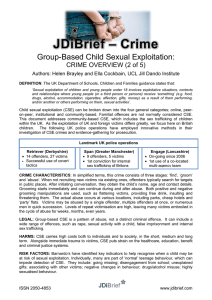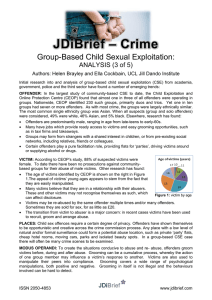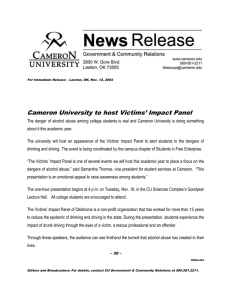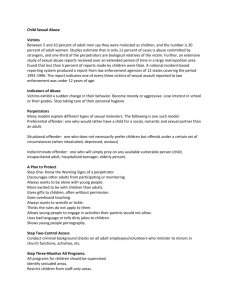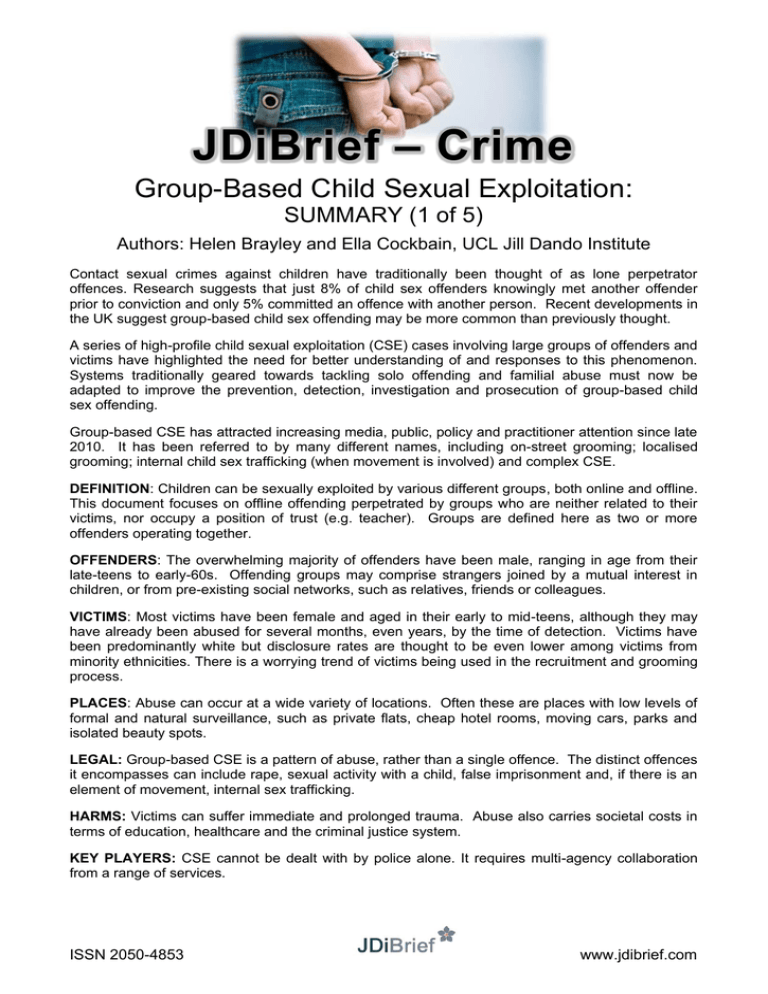
JDiBrief – Crime
Group-Based Child Sexual Exploitation:
SUMMARY (1 of 5)
Authors: Helen Brayley and Ella Cockbain, UCL Jill Dando Institute
Contact sexual crimes against children have traditionally been thought of as lone perpetrator
offences. Research suggests that just 8% of child sex offenders knowingly met another offender
prior to conviction and only 5% committed an offence with another person. Recent developments in
the UK suggest group-based child sex offending may be more common than previously thought.
A series of high-profile child sexual exploitation (CSE) cases involving large groups of offenders and
victims have highlighted the need for better understanding of and responses to this phenomenon.
Systems traditionally geared towards tackling solo offending and familial abuse must now be
adapted to improve the prevention, detection, investigation and prosecution of group-based child
sex offending.
Group-based CSE has attracted increasing media, public, policy and practitioner attention since late
2010. It has been referred to by many different names, including on-street grooming; localised
grooming; internal child sex trafficking (when movement is involved) and complex CSE.
DEFINITION: Children can be sexually exploited by various different groups, both online and offline.
This document focuses on offline offending perpetrated by groups who are neither related to their
victims, nor occupy a position of trust (e.g. teacher). Groups are defined here as two or more
offenders operating together.
OFFENDERS: The overwhelming majority of offenders have been male, ranging in age from their
late-teens to early-60s. Offending groups may comprise strangers joined by a mutual interest in
children, or from pre-existing social networks, such as relatives, friends or colleagues.
VICTIMS: Most victims have been female and aged in their early to mid-teens, although they may
have already been abused for several months, even years, by the time of detection. Victims have
been predominantly white but disclosure rates are thought to be even lower among victims from
minority ethnicities. There is a worrying trend of victims being used in the recruitment and grooming
process.
PLACES: Abuse can occur at a wide variety of locations. Often these are places with low levels of
formal and natural surveillance, such as private flats, cheap hotel rooms, moving cars, parks and
isolated beauty spots.
LEGAL: Group-based CSE is a pattern of abuse, rather than a single offence. The distinct offences
it encompasses can include rape, sexual activity with a child, false imprisonment and, if there is an
element of movement, internal sex trafficking.
HARMS: Victims can suffer immediate and prolonged trauma. Abuse also carries societal costs in
terms of education, healthcare and the criminal justice system.
KEY PLAYERS: CSE cannot be dealt with by police alone. It requires multi-agency collaboration
from a range of services.
ISSN 2050-4853
www.jdibrief.com

